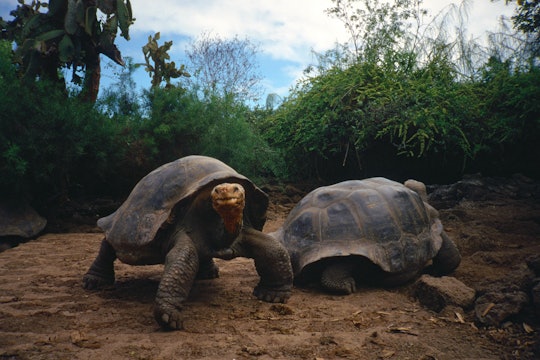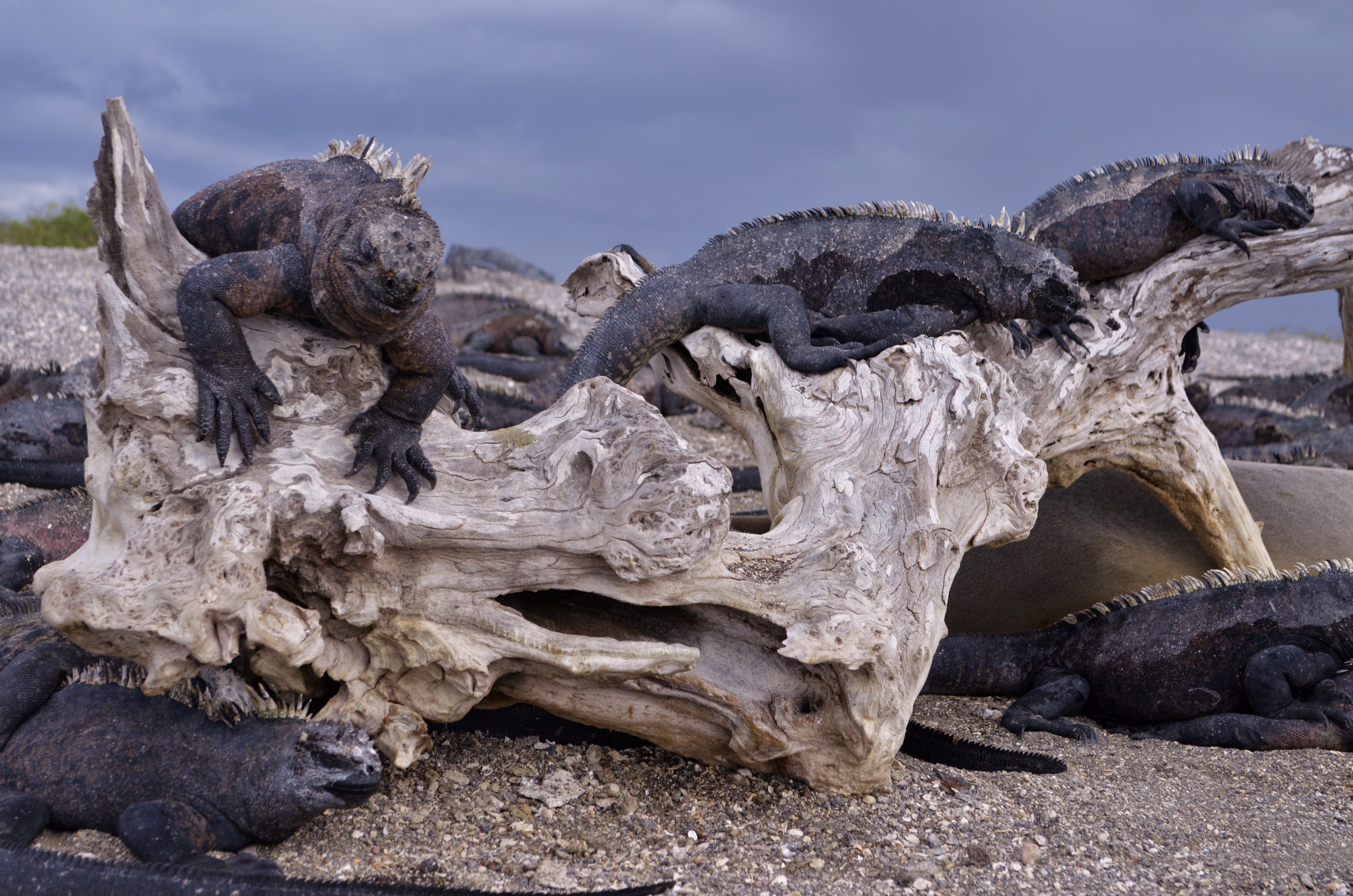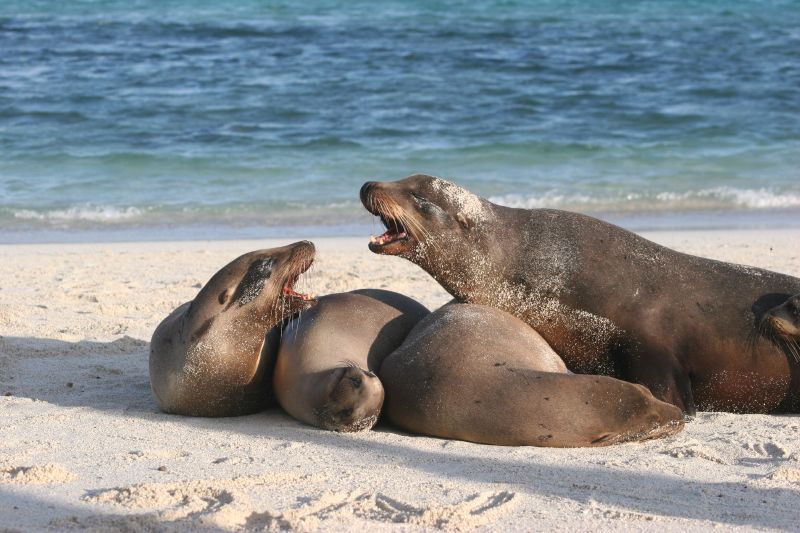
Boris Mann / Flickr
How to be a better tourist? Look to the Galápagos
Tourism accounts for 8 percent of greenhouse gas emissions. We can do more to limit our footprint, carbon and cultural
Flying on an airplane always gives me a rush, especially when the plane is heading toward the Galápagos. Without fail, the view of turquoise seas and lava rock-edged islands as we descend causes my heart rate to pick up. I've had the opportunity to travel to the Galápagos Islands six separate occasions – six round trip flights between North Carolina and the archipelago – as a part of my PhD research at Wake Forest University. To reach the field site on Isla Española, we take a plane, bus, taxi, and boat – all burning carbon-rich fuel, increasing my carbon footprint tremendously. Although I travel to the Galápagos for research, in many ways I'm still a tourist: I’m not a permanent resident of the archipelago and I buy food from restaurants and souvenirs from local shops, much like a tourist.

"Typical tourists."
Shai Gluskin / Flickr
Protected areas across the globe, like the Galápagos Islands, receive an estimated eight billion tourists each year and tourism is predicted to increase at a rate of 4 percent annually. A new study in Nature Climate Change calculated how tourism increases greenhouse gases that cause climate change; it found that tourism accounts for 8 percent of greenhouse gas emissions, with transportation, shopping, and food consumption being the biggest factors. Unsurprisingly, tourism's carbon footprint increases with increasing disposable income: The US has the greatest disposable income and the largest carbon footprint. Tourism is predicted to increase more than any other economic sector, particularly as the demand for exotic adventures surges. Tourism can provide a huge economic boost local economies, but it can also harm local culture and environment, and contribute to climate change. Should we stop traveling altogether?
Galápagos Islands: A case study
When I tell people where I work, they often exclaim “I would love to visit there someday,” and some have ask if tourism has ruined the Galápagos. I wondered, though the enchanted islands have undeniably changed since Darwin first visited in 1835, could there be any truth to this question?
After 1979, when the Galápagos were designated a UNESCO World Heritage Site, the number of tourists visiting the Galápagos increased to an unsustainable rate – the Galápagos National Park Directorate wasn’t prepared to handle so many visitors. In 2007, the archipelago was placed on the UN's list of endangered Word Heritage sites, but changes in biosecurity measures and conservation efforts resulted in its removal in 2010. Tourism to any place like the Galápagos is a balancing act of benefits and harms, which every visitor should keep in mind before traveling.
Good Practices: Benefits
- The Galápagos National Park protects 97 percent of the islands; humans (residents and agricultural activity) only occupy 3 percent of the archipelago. Visitors can buy local milk, cheese, and produce meaning those goods don’t have to be imported to the islands (using carbon-rich fuel) from continental Ecuador.
- The Galápagos National Park Directorate limits the number of visitors to specific tourist-approved sites. For example, Bahía Gardiner at Isla Española can only have, at most, four cruise boats at a time. The park coordinates with approved tour operators on these logistics to minimize the human effect on the local plants and animals.

A log cruise
pantxorama / Flickr
- The park asks all visitors to abide by 14 rules, such as not feeding the wildlife, which can cause health problems or a dependence on human food, and remaining on marked trails to prevent erosion and vegetation disturbance.
- Goods taken to the Galápagos must go through a quarantine process; for instance when crews on passenger planes, mid-flight, open overhead storage spaces and spray a pesticide to kill non-native insects. Before departing for our study site, we clean every bit of equipment, put the gear in sealed containers sprayed with insecticide, and leave it in a quarantine facility for 48 hours. Accidentally transferring an invasive species to an island could be devastating to the seabirds we study, and any number of other species.
- Local businesses, Galápagos residents, and conservation organizations, like Galápagos Conservation Trust, are working hard to make the archipelago plastic pollution-free. Stores no longer offer plastic bags – you need a reusable one – and many restaurants are going straw-free. Recycling is mandatory and residents have been fined for failing to recycle appropriately.
- Tourism creates huge economic benefits. Visitors to the Galápagos pay a mandatory $100 fee upon arrival, with the majority of the fee going to support the Galápagos National Park. Approximately 70% of the archipelago’s economy stems from tourism-related activities, and many of the 25,000 legal residents work in the industry as restaurant and hotel staff, taxi drivers, and national park guides.

taxing / Flickr
Potential Harms
- Today, more than 200,000 tourists annually visit the Galápagos, bringing the risks of new invasive species. More 866 non-native plant species have already been introduced across the archipelago. Most of these species sneak in accidentally – a seed stuck to a tourist’s sock or riding on a cargo ship might grow into a plant that can take over a landscape. Some were introduced as food crops, like the blackberry plant that now covers approximately 12% of the archipelago. Small insects and seeds can be difficult to prevent from entering the archipelago, even with the biosecurity measures. Organizations, like the Galápagos Conservancy, are helping to fund the development of effective control techniques for invasive species.
- While the rules laid out by the park are good and very important, they can be difficult to enforce. One of the most innocent rules to break: respect the two-meter (six-feet) distance from the wildlife. Animals on the Galápagos Islands evolved with no predators, making them appear “tame” and easy to approach. It's natural, at first sight of a large Galápagos tortoise, to want to step closer. But animals can be sensitive to our presence in imperceptible ways, like increasing stress hormone levels or metabolic rate. Seabirds in the Galápagos, for instance, avoid nesting close to tourist trails. Respecting these rules is crucial and sometimes overlooked, depending on the guide and tour.

"Do I look tame to you?"
Tak / Flickr
Be a better tourist
I love travel, and exploring a country can change your life – it was a semester studying abroad that directly shaped my professional path. Given my experiences and the travel necessary for work, I'm in no position to call a halt to traveling, but I hope that we can be good travelers. Though tourism and global travel can have negative consequences on the environment, we can easily start to reduce these effects.
- Research your destination ahead of time. Are sustainable tourism practices already in place?
- Consider choosing an environmentally friendly tour operator, or tour operators that give a portion of proceeds toward research or conservation. For example, Ecoventura, a tour operator in the Galápagos, will donate a portion of cabin sales to the Charles Darwin Foundation and Galápagos National Park.
- Reduce single-use plastic. Reusable water bottles and small reusable bags brought from home can help a lot. Avoid disposable plastic straws, which only get added to landfills, and check out alternatives that you can stick into a backpack easily.
- Eat at local restaurants and ask where the fresh fish or produce originates. Choose to eat at restaurants that serve seafood caught in-season, not illegally harvested.
- Shop at local stores, especially those selling products made from local artisans.
- Give careful thought to your souvenir purchases. Local shops in the Galápagos sell beautiful black lava and red coral jewelry – illegal when harvested from the Galápagos. When asked about the origin, the stores will say that they don’t come from the Galápagos; regardless of the origin, harvesting rare parts of nature is unsustainable.
- Be a considerate photographer. In the rush of the moment, it can be easy to forget where you are and try to get closer for a “more perfect” photo. Keep in mind that if you step off the path, you might cause an animal harm, damage small plants, cause erosion, or hurt yourself.
- If possible, give back to the area you visit. Conservation organizations gladly accept donations. Participate in the local conservation organization’s annual photo contest – it helps provide them with an endless number of promotional photographs.
- Consider staying more local. Explore a state or national park closer to home.
Since teleporting to destinations isn't yet an option, transportation-related tourism will continue to be a huge contributor to carbon emissions. But we can make some changes to what we do at our destination to be better tourists. If we keep in mind how our travels affect local communities, we can leave these natural areas in a beautiful state for generations to enjoy.
